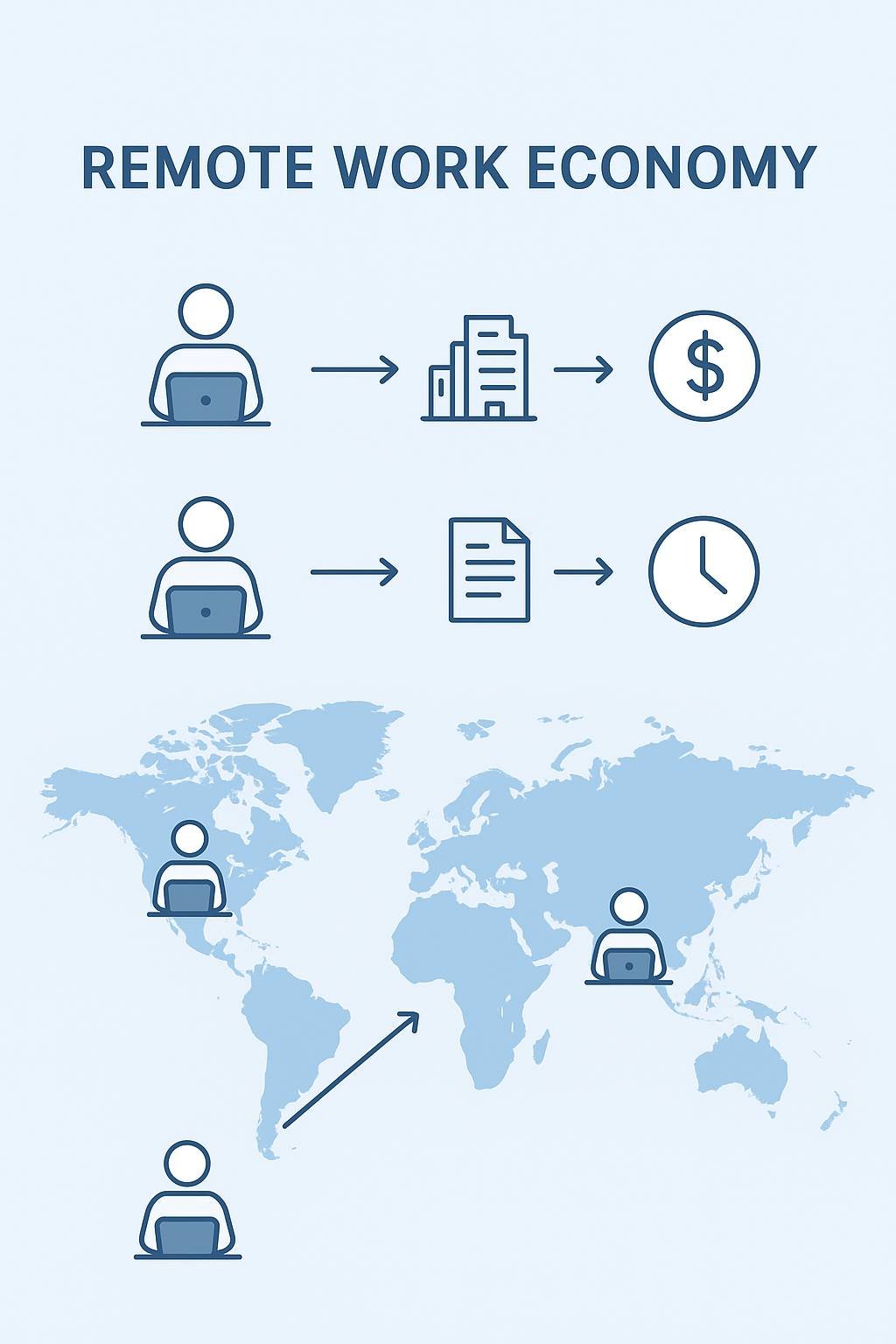Table of Contents
- Introduction: Why Side Hustles Matter in 2025
- Key Trends Driving Side Hustles in 2025
- Top 10 Side Hustles in the USA 2025
- 1. Digital Freelancing
- 2. Online Tutoring & Course Creation
- 3. E-commerce & Reselling
- 4. Content Creation & Affiliate Marketing
- 5. Virtual Services & Admin Support
- 6. Consulting & Coaching
- 7. Local Service Gigs
- 8. Gig Economy Driving/Delivery
- 9. Creative & Hands-On Hustles
- 10. Passive & Asset-Based Income
- Case Study: Side Hustle Success
- Future Outlook & Global Perspective
- Summary & Top Insights
- FAQs
Introduction: Why Side Hustles Are Important in 2025
In the US, side hustles, which are extra jobs or small businesses that people do in addition to their main job, are very common. Recent polls show that millions of Americans work part-time jobs. For instance, a Bankrate poll from early 2025 found that about 27% of adults in the U.S. had an active side job down from 36% in 2024. Even though this is a small drop, the overall trend is still strong. Almost half of younger Americans (ages 18 to 43) have a side job because they want to make extra money and have more freedom at work.
According to experts, the global gig economy was worth about $556 billion in 2024 and is growing quickly. Many experts say that in this climate, side jobs have gone from being a way to make extra money to a permanent part of the modern American workforce.
Economists say that when the economy gets worse, people tend to start side hustling again. Ted Rossman of Bankrate says that Americans often go back to part-time jobs when wages don’t keep up with inflation. At the same time, big companies are turning to freelancers more than ever.
Almost half of the CEOs who were asked said they would hire more freelancers in 2025. In short, side hustles are a big way for a lot of people to make money and grow their careers in 2025 not just a small trend.

Important Trends That Will Lead to Side Hustles in 2025
There are a lot of things that are making this side hustle boom happen in 2025. One big reason is the need for money. After years of rising prices and stagnant wages, a lot of Americans are turning to gig work to make ends meet. More than half of U.S. workers who started a side hustle in 2023 did so to make extra money, and more than a third of current side hustlers say they “always need” this extra money to pay their bills. These numbers show that for a lot of people a side job is no longer a choice it’s a need.
Changes in generations also have an effect. Younger adults are the ones who are most likely to have side jobs. About 48% of Gen Z (18–27) and 44% of millennials (28–43) have them, while only about 23% of baby boomers (60+) do.
This gap between generations shows how younger workers who are good with technology are changing the job market by taking on multiple jobs. A lot of them care more about being able to change jobs and learn new skills than about having a stable job. According to industry research almost half of all Gen Z say they have a side job which is the highest rate of any generation.
Technology and AI keep making it easier to find side jobs. It’s easier than ever to find remote work or sell things around the world thanks to websites like Upwork, Fiverr, Etsy, and YouTube. According to an Upwork report from 2024, if all freelancers around the world were a country, their combined earnings would be among the biggest in the world. In 2024, freelancers around the world made $1.5 trillion.
New AI tools make this effect even stronger. About 40% of workers say that AI has made it easier to find side jobs by automating boring tasks. For example, freelance writers can write content faster, and designers can prototype faster. AI also encourages people to learn new skills, since many freelancers use chatbots, design assistants, and other tools to stay competitive.
Finally, lifestyle factors are what make the trend happen. Not everyone who does side jobs in the US does them for the money. Many do them for freedom and satisfaction. Side Hustle Nation’s surveys show that about 78% of side hustlers say they like the freedom or personal growth these jobs give them; they’re not just doing it because they need the money.
Because they can set their own hours, independent workers often say they are happier at work and less stressed than traditional employees. With more and more people starting businesses (for example, 450,000 new business applications were filed in the U.S. in March 2025 alone), it’s clear that a lot of people are trying out business ideas outside of the 9-to-5 schedule.
In short, people do side hustles in 2025 because they need the money, it’s easy to do online, and it’s part of their culture. According to one World Economic Forum roundup, more Americans are likely to join the side-hustle economy because living costs are going up and there is a steady demand for flexible work.
By 2027 analysts expect about 26 million more U.S. workers to add a side gig. Side hustles are now a normal part of the work world, whether they are for extra money, passion projects, or to help a business grow in the future.

Top 10 Side Hustles in the USA 2025
1. Digital Freelancing
Freelancing online is still one of the biggest side jobs. Writers, designers, developers, marketers, and other skilled workers can find clients anywhere. For example, there are a lot of content writing and copywriting jobs on sites like Upwork and Freelancer.
These include writing blog posts, website copy, and marketing emails. Graphic and web design services like making logos, social media graphics, and site layouts, are also very popular, even for people who only have basic design tools. Freelancers who are good with technology can help with web development, app programming, or IT consulting. Freelancers who are good with digital marketing can help small businesses with SEO, social media campaigns, or email outreach.
Most of the time these freelance jobs pay well. Beginners might charge $20 to $50 an hour but experienced freelancers can charge a lot more. One entrepreneur who started out as a part-time writing tutor, saw her income rise from about $58,000 in 2020 to $222,000 in 2024 after she switched to full-time work. To get started, make a portfolio of sample work (even if it’s your own) and sign up for gig platforms or professional networks. Use AI tools like ChatGPT or Canva to get more done but keep in mind that clients pay for results and expertise.
Digital freelancing is a great way to make money with your professional skills because almost 51% of U.S. adults have done freelance work recently and many companies are hiring more freelancers.

2. Online Tutoring & Course Creation
There is still a lot of demand for remote teaching and training. Tutors and course creators are doing well because families and professionals are putting money into education. Tutoring in school subjects like math, science, and languages is becoming more popular, especially now that more students are learning from home.
A lot of tutors let you set your own schedule and meet with them over video calls. People still like to get language lessons in English or other languages on sites like iTalki or VIPKid.
Online courses are another way for experts and fans to make money from what they know. You can upload video or text courses on any topic, from cooking to coding, to platforms like Udemy, Teachable, or Skillshare. Building a course takes some work up front, but once it’s done, it can sell over and over again with little extra work, which is a great way to make money.
Tutors and coaches with a lot of experience often charge $20 to $50 an hour or more. For instance, one college admissions coach advertised her services in her area and through word-of-mouth, and her side business grew to $222,000 a year. Her plan was to focus on a small area (college essay coaching) and use word-of-mouth to get the word out.
If you know a lot about something, like school, work, or fitness, you can make a lot of money on the side by coaching or tutoring people online. This is especially true if you focus on a certain group of people and use testimonials or credentials to build your reputation.
3. E-commerce & Reselling
Selling products online is a proven side hustle path. One approach is craft and handmade goods: artists or crafters can sell custom items (jewelry, artwork, knitwear, digital prints) on marketplaces like Etsy or on their own Shopify store. Thanks to print-on-demand services, you can also design T-shirts, mugs or posters without holding inventory.
Reselling and dropshipping are popular too. Resellers buy things at a discount (from garage sales, thrift stores, or wholesale) and then sell them on sites like Amazon, eBay, or Poshmark for full price. A DollarSprout survey found that nearly 40% of side hustlers engage in selling or flipping goods.
Dropshipping lets you run a store without inventory by forwarding orders to a supplier, though it requires good product research and customer service.
Earnings vary widely in e-commerce. A lot of part-time workers make a few hundred dollars a month, but dedicated sellers can make thousands by picking the right products and marketing them well. According to Hostinger’s 2025 data, people who work side jobs make about $891 a month, usually part-time.
Important tips: Look into trending or niche products, write clear product descriptions that are good for SEO, and ask for good reviews. Investing early earnings back into advertising or inventory can help scale the business. More people than ever are buying things online, so a smart e-commerce side business can grow quickly in 2025.
4. Content Creation & Affiliate Marketing
Building an audience and making money from your content is a strong side job, but it takes time. This includes blogging, making YouTube videos, making podcasts, or being a social media influencer.
You write articles, make videos, record podcasts, or post on social media about something you love or are an expert in (like tech reviews, fitness tips, or DIY projects) and build an audience over time. You can make money from ads, sponsorships, or affiliate marketing as more people watch.
Affiliate marketing is common. For instance, a blogger might write reviews of products and link to them through an affiliate program, like Amazon Associates. They would then get a cut of any sales made through those links.
An influencer on Instagram might work with brands to make sponsored posts. It takes time to build a following, but there are success stories. Once top content creators reach a certain number of followers they can make thousands of dollars a month.
To be successful you should focus on a specific niche use SEO or video keywords to improve search and engagement and post the same content on more than one platform. A tech YouTuber for instance could post short tips on TikTok and longer reviews on YouTube to reach different kinds of people.
Even creators who only make a few things can make good side money. For instance, a niche blog or YouTube channel that posts regularly can eventually make money from ads or affiliate links without having to do anything.
Side Hustle Nation says that a lot of side hustles that make a lot of money (five figures a month) started out as blogs, podcasts, or video channels. The most important things are quality and consistency. The more useful and regular your content is, the more viewers and money you can make over time.
5. Virtual Services & Admin Support
A lot of small businesses and entrepreneurs hire virtual assistants (VAs) and freelancers to do simple tasks for them. Virtual assistants can do things like manage your email, set up your calendar, help customers, or do light bookkeeping. Starting pay can be between $15 and $30 per hour.
Social media managers also make posts, run ads, and interact with people for small businesses that don’t have full-time employees. SEO and digital marketing freelancers improve websites and campaigns, and they usually make between $30 and $100 an hour.
Transcription and translation are two other services that are in high demand. Transcribers write down what people say in meetings, podcasts, or legal recordings, and translators change documents from one language to another.
These jobs pay by the hour or by the word, and there is always a need for them (for example, transcription is always needed in the legal and medical fields). Platforms like Upwork show that administrative and marketing support jobs are still the most in-demand.
The best thing about virtual services is that they are stable. You can get a few regular clients and do work for them every week. To get started, make a professional profile that shows off any relevant experience you have, even if it was unpaid.
You might also want to offer a trial project to get your first client. Being able to communicate and organize well is very important. Small business owners still value these services in 2025 so virtual assistants and online support specialists can easily make extra money from home.
6. Consulting & Coaching
If you have a lot of experience in a field, consulting can pay very well. For instance, business people can offer part-time consulting to help startups or nonprofits with their marketing, finances, or operations.
IT or legal professionals can work on special projects on the side. Wellness coaching (fitness, nutrition, mindfulness) and career coaching (building a resume, getting ready for an interview) are two more examples. You can get these services online through video calls or in some cases in person.
Depending on their level of experience and area of expertise consultants usually charge between $50 and $200 per hour. Consulting is usually project based or packaged, like a set number of sessions or a deliverable unlike hourly jobs. It’s very important to build trust.
A well-written LinkedIn profile, good reviews, or a personal website that shows off your skills will all help you get clients. One good thing is that satisfied customers often tell other people about you. Basically, consulting lets you make a lot more money from your full-time job skills than a part-time job, so it’s a great side job for professionals.
7. Local Service Gigs
Not all side jobs are done online. Local, in-person services are still very useful and usually don’t need much formal training. One example is pet care. Walking dogs or taking care of pets on apps like Rover can pay $15 to $30 per visit.
Another option is home services. You can make $20 or more an hour by cleaning houses, mowing lawns, or doing basic repairs. A lot of people use neighborhood apps, flyers, or sites like TaskRabbit to promote these services.
Creative event services are also side jobs. For example, amateur photographers can take family portraits or pictures of small events on the weekends, and home cooks can cater for local events or bake cakes on request. These jobs usually pay by the job, like a photographer who charges a flat fee for an event.
This can sometimes lead to higher hourly rates. Trust from customers is very important for local businesses. Good reviews and word-of-mouth referrals will help your business grow quickly in the area. Even though app-based tech doesn’t directly bring in clients, sites like Yelp and Nextdoor can help. For a lot of people, local gigs are a great way to get away from screens and make some extra money.
8. Gig Economy Driving/Delivery (with Caution)
Uber, Lyft, DoorDash, UberEats, and Instacart are all popular side jobs because they are flexible. You can use an app to make money whenever you want. But recent studies show that these jobs often don’t pay much after expenses.
For example, drivers who pay for gas, car repairs, insurance, and taxes may only make the same amount as the minimum wage or less. After costs, DoorDash drivers might only make about $1.45 an hour, and Uber drivers might make about $10.50 an hour.
That being said, many people still like driving jobs for extra money or as a side job. If you go this route, you should be smart about it: only drive during peak hours (weekdays evenings and weekends), use cars that get good gas mileage, and keep track of your expenses so you can get tax breaks. Think of it as a backup plan or a part-time job instead of a way to make a lot of money.
Most gig drivers in 2025 probably only use it for extra money or to make ends meet because of competition and overhead. A rideshare side job can be like a fragile airplane if you don’t plan carefully. If you don’t take into account all the costs, it could crash financially. In short, this type of side job gives you the most freedom but it usually pays less than many of the other side jobs on this list.
9. Creative & Hands-On Hustles
You can turn a creative hobby or useful skill into a paying side job. Artisans can make money from their work by selling things like handmade jewelry, pottery, or art prints on Etsy or at local markets.
People who aren’t professionals but have photography gear can take pictures of people or events and sell prints or stock photos online. Stock photo sites like Shutterstock and Adobe Stock let you make money every time someone downloads one of your pictures.
People who are good at trades can find extra work in home repairs and improvements. You can easily make $20 or more an hour doing things like painting rooms, putting together furniture, or doing basic plumbing work.
People who work in the garden or around the house put up ads on community boards to rake leaves, mow lawns, or fix fences. These hustles often use project-based pricing, which means that one good-paying project can bring in more money than a low-paying hourly job.
To do all of these things, you’ll need to put in some work. For example, you might need to show off your work with clear examples, like good photos of your crafts or a portfolio of past jobs, and get reviews from people in your area. Creative side jobs can turn into small businesses over time.
For instance, one person who enjoys making things turned her side job into a part-time job by focusing on unique designs and selling them through social media. People who like making and doing things will enjoy these hustles, and they often pay a lot more per hour than regular jobs.
10. Passive & Asset-Based Income
Some of the best side jobs in 2025 that pay well are “passive” because they use things you already own. One way to make money is to invest in real estate.
If you own property, you can rent out an extra room or home (even through Airbnb for short stays) and make money every month. You need some money to start and some work (like cleaning or managing tenants), but it’s a common way to make extra money.
Digital goods are another way to make money without working. When people buy your e-book or online course, you get paid. For example, if you self-publish a book on Amazon Kindle, you can make 40–60% of the sales, and a well-marketed book can sell for years.
Selling stock music, printable templates, or software plugins can also lead to repeat sales. The most important thing is to put in the work up front. Create something useful (like a course outline, a book manuscript, or a digital design) and then sell it on sites where customers can buy it over and over again.
Investments also count: stocks that pay dividends, bonds, and peer-to-peer lending won’t make you rich overnight, but they can help you make extra money. These jobs are riskier and usually need more money, so they aren’t like “gig” jobs. But a lot of smart side hustlers invest some of their money to grow their wealth. In short, think of passive streams as long-term projects. Learn about them, start small (maybe with one property or one course), and then grow over time.
Many experts agree that the best way to make money over time is to combine active side jobs with passive income, such as renting out property or earning royalties.

Case Study: Side Hustle Success
A good example is the real story of Carter Osborne, a college essay tutor in Seattle. In 2017, Osborne started helping high school students with their college application essays as a side job while still working full-time.
He found a small group of people who needed help getting into Ivy League or other competitive colleges and focused his marketing on getting referrals from local teachers and parent groups.
Osborne’s side business grew a lot over the next few years. He could charge more because he focused on a busy time of year (the summer and fall college application cycles). He went from making about $58,000 a year as a part-time tutor in 2020 to $114,000 a year in 2023.
Osborne took a big step in 2024 when he quit his day job and started tutoring full-time. His tutoring business made $222,000 that year. Osborne says he was able to succeed by using his knowledge, networking aggressively (including a polished LinkedIn profile), and smart scheduling (working 50–70 hours a week during peak season and then taking breaks during the off-season).
His story shows that if you plan properly, a side business can start small and evolve into a six figure success. Osborne made tutoring his full time job by treating it like a business he kept account of his expenses, made a respectable website and earned the trust of his clients.
This example makes an important point: to be successful with a side business, you often need to be persistent, know your niche, and use every happy customer as a marketing tool.
Future Outlook & Global Perspective
Side hustles have a bright future. The gig economy is growing around the world, and experts think it will be worth about $2.1 to $2.5 trillion by 2033. There are a lot of entrepreneurs in the US. For example, in March 2025, more than 450,000 new business applications were filed, showing that many side hustles are becoming real businesses.
Digital platforms connect millions of workers around the world. Right now, more than 130 million people make most of their money from online jobs which shows how big remote freelancing is.
These trends will keep changing because of technology. AI automates some jobs but it also makes new ones like AI data trainer and prompts specialist. A report from the World Economic Forum says that about 86% of employers think AI will change jobs by 2030.
Smart side hustlers will use AI tools for research, writing, design, and other tasks to get more done and stay ahead of the competition. At the same time, the most important human skills like building relationships, thinking outside the box, and giving personalized service, are still useful.
Experts agree that side jobs are a good idea because they give you stability and flexibility in a changing the economy. They help Americans adjust to changing job markets by giving them more ways to make money. You need to keep up with what people want and learn new things all the time if you want to be successful in the long run.
For example freelancing in the areas of technology or healthcare is likely to become more popular and new niches can develop, such as services for living sustainably or virtual reality.
In short side hustles are probably here to stay as platform economies and startup culture grow. The global market, startup activity, and digital connectivity all show that more people are making money from their passions and skills.
In 2025 side hustlers can build long lasting profitable businesses alongside or in addition to their day jobs by focusing on useful skills and learning how to use new tools.

Summary & Top Insights
In 2025, side jobs will be a normal part of American work life. Almost half of younger adults have a side job and the total number of people with side jobs is still high.
vFreelancing, online tutoring, e-commerce, content creation, and virtual services are some of the best side hustles because they use online skills and digital platforms. Recent surveys show that freelancing and selling things online are two of the most common and rewarding jobs.
Choosing the right side job means finding one that fits your skills and the needs of the market. Use current information and research. For example, surveys show that reselling goods and providing professional services like consulting or marketing are consistently among the best ways to make money. Not all side jobs make the same amount of money. For example, consulting, specialized tech work, and digital courses can make thousands of dollars a month, while gig driving usually only makes a little bit of money after expenses.
The big picture is good, though: predictions of growth in the global gig economy and more people starting their own businesses point to a lot of opportunities. In 2025, the most successful side hustlers will be those who choose fields that are in high demand, treat their gig like a small business, and keep up with changes in the economy and technology.
📌 Frequently Asked Questions
A side hustle is any extra job or business you do alongside your main work. It can be a freelance gig, a small business, or a part-time service. The key is flexibility and pursuing something you enjoy or are skilled at.
Start with your skills and interests. If you write well, try freelance writing; if you’re good at teaching, consider tutoring; if you have technical skills, pick a freelance tech gig. Consider startup cost and time commitment. Use data (like demand stats or Google Trends) to choose ideas that grow with market needs.
It varies widely. Many Americans earn a few hundred dollars a month; one survey found average side income around $891/month (hostinger.com). But top hustlers can make thousands monthly if they scale. Keep expenses low and reinvest in growing your gig.
Yes. In the USA, income from side jobs is taxable. You should track all income and expenses (like equipment, travel) on Schedule C of your tax return. Use accounting tools or consult a tax pro to handle self-employment taxes properly.
AI will change how some tasks are done, but it also creates new gig roles (e.g. AI content design, data labeling). Most side hustles that require human skills (teaching, creative content, consulting) will still need people. In fact, 78% of CEOs say freelancers deliver more value than full-time staff (upwork.com), so many businesses still value human-led side work.


